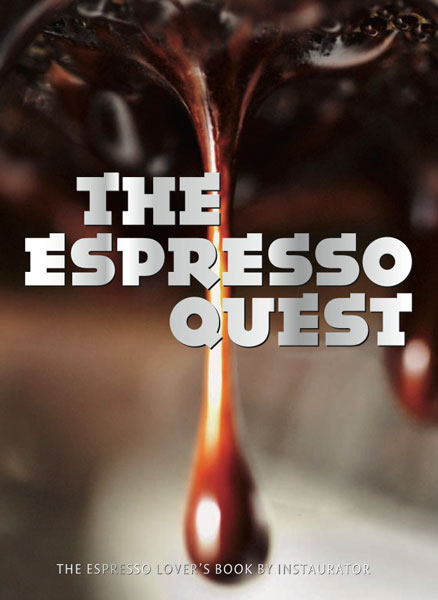Products You May Like
There’s another new book on the horizon, and I’ve been privileged to have received a preview copy of the book in pdf format, which I’m just reading through now.
That book is by my friend and coffee confidant, Instaurator, of Michelle Espresso Fame, WBC fame, and of course, his own fame! The book is called The Espresso Quest, The Espresso Lover’s Book. It’s part personal journey in coffee, and part educational. It’s filled with amazing anecdotes and even more amazing photography.
And here’s an excerpt from the book – totally copied here without Inny’s permission. This is the first few pages from the first section, called The Taste.
THE QUEST BEGINS: ESPRESSO EXODUS
Coffee has always enjoyed local variations, and there is no doubt that these guidelines will incite further vigorous debate. There are few hard and fast rules as to what is considered a standard espresso, and this is evident in different parts of the world. Fast-maturing espresso markets such as Sydney or Melbourne, and Seattle or Vancouver in North America, each define the perfect espresso differently. This is true within a single city as well, much like it has been in Sydney for some time (although it may be changing). In my hometown, the harbor where the world-famous opera house sits divides the city in two. On the north side of the harbor, espresso tends to be a bit milder than the full-bodied and powerful Robusta-blend espressos found closer to downtown on the southern side of the harbor. Regardless of where espresso is enjoyed, the indispensable rule is: Always let your taste be your guide.
For centuries, coffee has incited numerous controversies and passionate discussions around the world. I believe that this is healthy as long as it leads to the gathering of wisdom. Unfortunately, wisdom is so elusive because it is one step beyond knowledge. Knowledge comes from learning the information, facts, ideas or principles. Wisdom comes from actively applying knowledge to a practical test. Someone once said that wisdom is 90 percent hindsight. There is a lot of truth to this. Through experience, a person learns the tricks of the trade to avoid common pitfalls, and in the process gains wisdom.
George came from the sensory-inspired European school of espresso, whereas I came from the scientific-based analytical school. This so-called European (or Italian) approach involves more of the senses, whereas the scientific school is more about measuring grams and liquid volumes in an attempt to try to record the myriad variables involved in creating an espresso. Both of us, however, were united in testing our ideas through practical experiments.
George and I instantly joined forces. I paid for him to fly to Monte Carlo and compete in the inaugural World Barista Championship in 2000. We jumped on the plane together and proceeded to have a lot of fun as we passionately discussed our differing views about espresso. The one thing that united us, in spite of our different approaches, was that we both always let our taste guide us.
Being near the Italian border in Monte Carlo, we came upon many seasoned Italian espresso drinkers. Upon trying my coffee blend at our practice sessions they would refuse to believe that it had been roasted and blended in Australia. they told me tasted too good, therefore it must be Italian. It was a wonderful compliment. I felt assured they were letting taste be their guide!
The European school of espresso is evident in the old school Italian baristas, who can still be found in large cities around the world, although you may have to go a long way to find one.
Sadly, I have heard reports that the professional barista is in decline in Italy. These good baristas know what an appropriate grind feels like. They know what a good pour looks like. They know how used coffee grinds should smell. They can tell if the water is too hot, the coffee too stale or too fresh, just by the way the crema looks. Armed with a basic sensory appreciation, they can produce a sublime espresso that beats one prepared by a so-called scientific barista time and time again. Unfortunately, these baristas seem to be a dying breed, as they are increasingly replaced by fully automatic machines. Why won’t a fully automatic espresso machine produce a more consistent espresso than an imperfect human? We’ll touch on that later.
Regardless of which school the barista comes from, in the end, good baristas must be good tasters of coffee. The barista must be able to recognize how variables in brewing affect the flavor in the one place it counts – in the cup. There is no getting away from it. The barista must be able to taste. Otherwise they are merely dressing a window. and the customer will never find what they are looking for in their cup.
The best baristas combine a few common characteristics. They are curious about what they don’t understand. They take care to present their coffees with a unique signature style. They understand they are performers and their customers are the audience to whom they project their personality and passion. Always strict and severe with their coffee standards, they communicate this dedication and passion to their audience through their character, as well as through their beverage. They can be flirtatious, merely hospitable or a downright Coffee Nazi. But most importantly, they always love tasting their espresso coffees.
Taste is as important for the barista as it is for the customer. When interviewing potential staff; for a position in one of my espresso bars, I quickly learned to ask the hopeful employees if they liked coffee. Without liking the material you are working with, it is very difficult, if not impossible, to have a sympathetic understanding of the product and the customer who purchases it. This is one of the unspoken things customers pick up on. And often without even realizing it, customers will gravitate towards the café that is staffed by baristas who are passionate about their product.
On the other hand, there are also those baristas who can create fancy patterns with milk or chocolate mixed with crema, but sadly they don’t have a fundamental understanding of, and sympathy for, the brewing of coffee. Their passion for excellence is lacking, which is an essential piece in a larger puzzle. Without passion, the so-called “Espresso-X Factor,” is missing. This passion combined with hard-headed, good organizational skills, is the key to many outstanding and successful businesses and is the true Espresso-X Factor.
My scientific approach to espresso came from my training. I learned to carefully and laboriously weigh and set a commercial grinder to dispense a precise weight of coffee grinds, accurate down to a tenth of a gram. What I have since come to realize is that the trouble with this method is that different roast colors and blends will have different densities. So, once the grinder is set for a particular roast, it will need to be reset for one that varies even by a couple of points on an Agtron spectrophotometer scale. (A spectrophotometer, which measures roast color, is as essential to good coffee roasting as a thermometer.)
What I have found during my extensive experimentation, is that beans that look exactly the same to the naked eye, can taste extremely different depending on how those beans have been roasted. The spread of difference between the color reading of the outside of the bean and the coffee inside, is also critical to good flavor development and can only be measured accurately with a spectrophotometer. I also learned during my scientific training that the speed at which the lever on the side of the grinder is pulled will vary the amount of coffee that drops into the portafilter. This too will vary according to the coarseness or fineness of the coffee grinds. Dosing by weight rather than volume reveals a lack of understanding of the ‘coffee press,’ which is absolutely necessary in order to make a succulent espresso. This small, but important element, can make the brewing of espresso coffee a very inexact, frustrating, and elusive science.
There you go – the book is pretty exciting. I’m mentioned exactly once in it, and only mentioned as a foil to Inny’s eventual point where he futilely tries to prove you can have good espresso from single origin coffee. It should be available soon.


